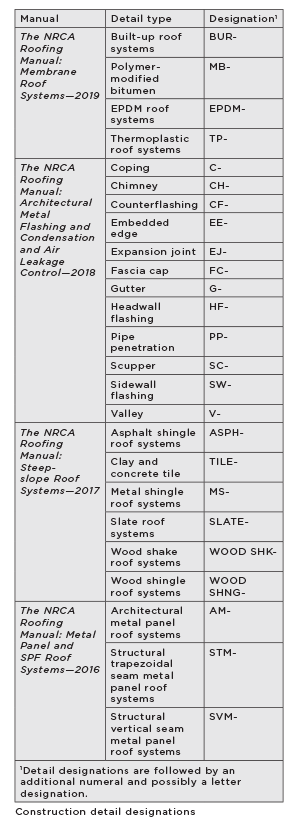Proper design of construction details is important to a roof system’s performance and longevity. NRCA provides guidance to roof system designers—and the roofing industry in general—regarding design and installation quality for long-term performing roof system construction details.
NRCA construction details
NRCA provides more than 620 construction details applicable to various roof system types in The NRCA Roofing Manual. The four volumes of the manual are: The NRCA Roofing Manual: Metal Panel and SPF Roof Systems—2016, The NRCA Roofing Manual: Steep-slope Roof Systems—2017, The NRCA Roofing Manual: Architectural Metal Flashing and Condensation and Air Leakage Control—2018 and The NRCA Roofing Manual: Membrane Roof Systems—2019.
Each volume contains construction details for specific roof system types. For example, construction details for asphalt shingle roof systems are provided in Chapter 6—Construction Details in the Asphalt Shingle Section of The NRCA Roofing Manual: Steep-slope Roof Systems—2017. Asphalt shingle roof system construction details are denoted as “ASPH-” followed by a number and sometimes a letter (for example, ASPH-3 and ASPH-3A).
Construction Detail ASPH-3—Eave With Water and Ice-dam Protection Membrane depicts NRCA’s preferred method for addressing an eave detail using a water and ice-dam protection membrane with a stripping ply over the drip edge metal. Construction Detail ASPH-3A—Eave With Water and Ice-dam Protection Membrane depicts an alternative detail NRCA also considers acceptable based on any limitations described in the detail’s notes.
Many construction details for specific roof system types depict common sheet-metal flashings. Consult the construction details in the Architectural Metal Flashing Section of The NRCA Roofing Manual: Architectural Metal Flashing and Condensation and Air Leakage Control—2018 for specific guidance and options specific to architectural metal flashings.
NRCA’s construction details are presented in the same time-tested, best industry practices context on which The NRCA Roofing Manual is based. In some instances, the construction details are more conservative than manufacturers’ standard construction details. Manufacturers’ standard construction details typically are based on the specific manufacturer’s minimum requirements to achieve a specific warranty term. As a result, NRCA’s construction details may be more complex and labor-intensive (and more costly) to install than others’ standard details.
Using NRCA’s details

NRCA’s construction details are intended to provide a basis for roof system designers to develop project-specific construction details for conditions applicable to their projects. It is unlikely simply copying NRCA construction details will adequately reflect project-specific conditions.
For example, NRCA’s construction details depict roof decks and vertical flashing substrates as generic, nonspecific materials. Roof system designers should incorporate their project-specific roof deck and vertical flashing substrate material types into construction details.
Similarly, common conditions, such as insulation thicknesses and flashing heights, are depicted in NRCA’s construction details as standard dimensions. Roof system designers should incorporate their project-specific thicknesses, dimensions and any other appropriate parameters into their construction details.
To help roof system designers use and customize NRCA construction details to project-specific conditions, NRCA’s construction details are available as AutoCAD®-compatible (.dwg) files.
The four-volume set of The NRCA Roofing Manual, individual volumes of the manual and The NRCA Construction Details: CAD Files—2019 are available to NRCA members as free downloads through NRCA’s website, www.nrca.net; nonmembers can purchase the CAD files. A hard copy version of The NRCA Roofing Manual four-volume set and individual manual volumes are available for purchase at www.nrca.net.
Mark S. Graham is NRCA's vice president of technical services.
@MarkGrahamNRCA
This column is part of Research + Tech. Click here to read additional stories from this section.



